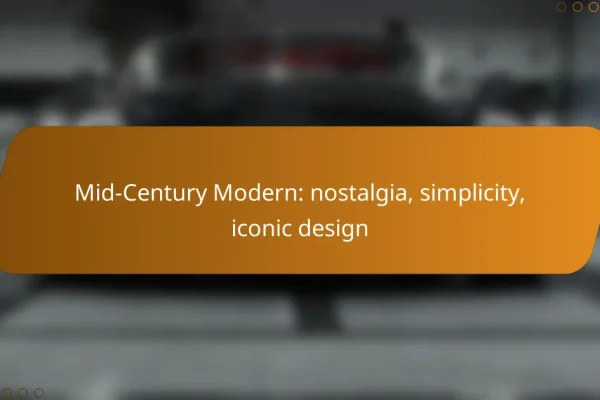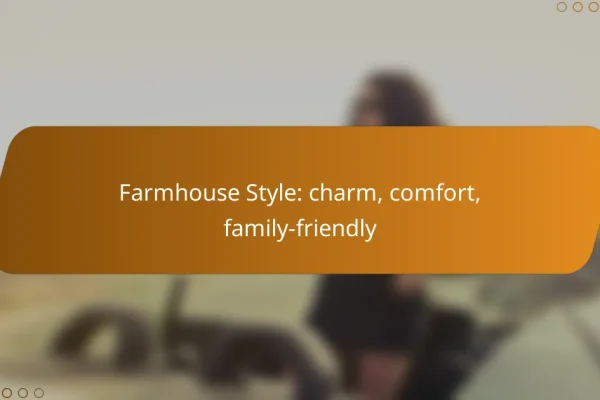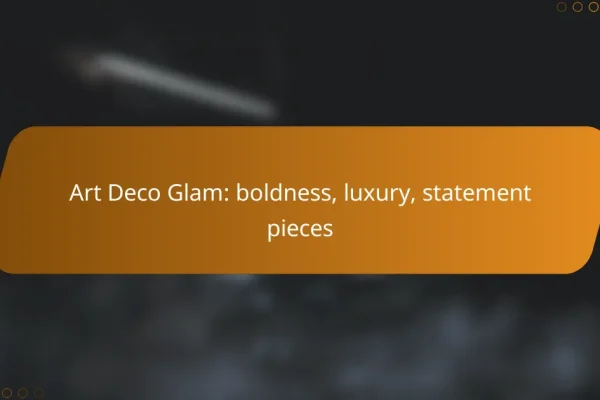What are the best home decor styles for modern homes?
The best home decor styles for modern homes include minimalist decor, Scandinavian design, industrial style, bohemian aesthetics, and mid-century modern. Each of these styles offers unique characteristics that can enhance the functionality and aesthetics of your living space.
Minimalist decor
Minimalist decor focuses on simplicity and functionality, emphasizing clean lines and a clutter-free environment. This style often features a neutral color palette, with an emphasis on natural light and open spaces.
To achieve a minimalist look, choose furniture with simple shapes and avoid excessive ornamentation. Incorporate storage solutions that keep items out of sight, and select a few statement pieces to maintain visual interest without overwhelming the space.
Scandinavian design
Scandinavian design is characterized by its warmth, simplicity, and functionality, often incorporating natural materials like wood and textiles. This style promotes a cozy atmosphere through light colors and soft textures.
To create a Scandinavian-inspired space, focus on a neutral base with pops of color through accessories. Use functional furniture that combines aesthetics with practicality, and consider adding plants to bring a touch of nature indoors.
Industrial style
Industrial style draws inspiration from warehouses and factories, featuring raw materials such as exposed brick, metal, and wood. This decor style often embraces a rugged, unfinished look that adds character to modern homes.
To implement industrial design, incorporate elements like metal light fixtures, reclaimed wood furniture, and open shelving. Keep the color scheme muted, using grays, browns, and blacks to enhance the industrial vibe.
Bohemian aesthetics
Bohemian aesthetics celebrate individuality and creativity, characterized by vibrant colors, eclectic patterns, and a mix of textures. This style encourages personal expression through unique decor items and layered textiles.
To achieve a bohemian look, mix and match furniture and accessories from different cultures and eras. Use bold colors and patterns, and incorporate plants and handmade items to create a warm, inviting atmosphere.
Mid-century modern
Mid-century modern design is known for its clean lines, organic shapes, and a focus on functionality. This style often features a mix of traditional and non-traditional materials, creating a timeless appeal.
To embrace mid-century modern decor, select furniture with tapered legs and geometric shapes. Use a color palette that includes rich hues like mustard yellow, teal, and olive green, and incorporate iconic pieces from the era to enhance the overall aesthetic.
How do I choose a home decor style that fits my personality?
To choose a home decor style that aligns with your personality, start by reflecting on your tastes and preferences. Consider what colors, textures, and themes resonate with you, as well as how you want your space to feel.
Assessing personal preferences
Begin by exploring various decor styles such as modern, rustic, or bohemian. Create a mood board with images, colors, and materials that appeal to you. This visual representation can help clarify your aesthetic and guide your choices.
Think about the emotions you want your space to evoke. For instance, if you prefer a calm environment, softer colors and minimalistic designs may suit you better than bold patterns and heavy furnishings.
Identifying lifestyle needs
Your lifestyle plays a crucial role in determining the right decor style. Consider factors like family size, pets, and how you use your space. For example, a family with young children might benefit from durable materials and easy-to-clean surfaces.
Evaluate your daily routines and activities. If you often entertain guests, an open layout with comfortable seating and a welcoming atmosphere may be essential. Conversely, if you value quiet and solitude, a more intimate and cozy setting might be preferable.
What factors should I consider when selecting home decor?
When selecting home decor, consider your personal style, the functionality of the space, and how various elements will work together. Key factors include room size, color schemes, and furniture compatibility, all of which influence the overall aesthetic and comfort of your home.
Room size and layout
The size and layout of a room significantly impact your decor choices. In smaller spaces, opt for lighter colors and multifunctional furniture to create an illusion of openness. Conversely, larger rooms can accommodate bolder colors and larger pieces, allowing for more dramatic decor.
Consider the flow of the room as well. Arrange furniture to promote easy movement and interaction, avoiding cluttered pathways. Use area rugs to define spaces within larger rooms, helping to create distinct areas for different activities.
Color schemes and palettes
Your color scheme sets the mood for your space. Choose a palette that reflects your personality and complements the room’s purpose; for example, calming blues and greens work well in bedrooms, while vibrant reds and yellows can energize a kitchen.
When selecting colors, consider the natural light in the room. Bright, sunny spaces can handle darker shades, while dimly lit areas benefit from lighter tones to enhance brightness. A common approach is to use a base color with two or three accent colors for a cohesive look.
Furniture compatibility
Ensure that your furniture complements your chosen decor style and fits well within the space. Measure your room and furniture to avoid overcrowding, leaving enough space for movement. Consider the scale of your furniture; oversized pieces can overwhelm a small room, while tiny items may get lost in a large space.
Additionally, think about the materials and textures of your furniture. Mixing different materials, such as wood, metal, and fabric, can add depth to your decor. However, maintain a balance to avoid a chaotic look; aim for harmony in both style and texture across the room.
How can I blend different decor styles in my home?
To blend different decor styles in your home, start by identifying key elements from each style that resonate with you. Focus on creating harmony through consistent themes, colors, and textures to ensure a cohesive look throughout your space.
Creating a cohesive look
A cohesive look is achieved by selecting a few core styles to feature in your home. Limit your choices to two or three styles to avoid visual clutter. For example, combining modern and rustic elements can create a warm yet contemporary atmosphere.
Consider using common furniture pieces or accessories that reflect both styles. A modern coffee table paired with rustic wooden chairs can bridge the gap between the two aesthetics.
Using color as a unifier
Color plays a crucial role in blending different decor styles. Choose a color palette that incorporates shades from each style to create a sense of unity. For instance, if you have a vintage style with muted tones, you can introduce brighter accents from a modern style to enhance the overall look.
Using a consistent color scheme throughout your home can help tie together various elements. Aim for a balance of neutral base colors with pops of color that reflect the different styles.
Balancing textures and patterns
Mixing textures and patterns can add depth to your decor while maintaining a cohesive feel. Use a variety of materials, such as wood, metal, and fabric, to create visual interest. For example, a plush velvet sofa can contrast beautifully with a sleek glass coffee table.
When incorporating patterns, stick to a few key designs that complement each other. A geometric rug can work well with floral cushions if the colors align. Aim for a balance that feels intentional rather than chaotic.
What are the current home decor trends in the United States?
Current home decor trends in the United States emphasize sustainability, technology integration, and bold design choices. Homeowners are increasingly looking for ways to create stylish yet functional spaces that reflect their values and lifestyles.
Sustainable materials
Sustainable materials are becoming a key focus in home decor, with many homeowners opting for eco-friendly options. This includes using reclaimed wood, bamboo, and recycled metals, which not only reduce environmental impact but also add unique character to spaces.
When selecting sustainable materials, consider certifications such as Forest Stewardship Council (FSC) for wood products or Global Organic Textile Standard (GOTS) for textiles. These certifications ensure that materials meet specific environmental and social criteria.
Smart home integration
Smart home integration is increasingly popular, allowing homeowners to enhance convenience and energy efficiency. Devices like smart thermostats, lighting systems, and security cameras can be controlled remotely, making it easier to manage home environments.
When incorporating smart technology, prioritize compatibility with existing systems and ease of use. Look for devices that can be integrated into a single app for seamless control, and consider energy-efficient options to reduce utility costs.
Maximalism revival
The revival of maximalism encourages bold colors, patterns, and eclectic decor choices. This trend contrasts with minimalism by embracing a more vibrant and personalized aesthetic, allowing homeowners to express their individuality through their decor.
To successfully implement maximalism, mix various textures, colors, and styles while maintaining a cohesive theme. Use statement pieces, such as oversized art or unique furniture, to create focal points and avoid overwhelming the space.
How do I shop for home decor online effectively?
To shop for home decor online effectively, start by researching various retailers to find the best selection and prices. Utilize filters to narrow down options based on style, budget, and size, ensuring you find items that fit your space and preferences.
Comparing prices across platforms
When comparing prices for home decor, check multiple online platforms such as Amazon, Wayfair, and local retailers. Prices can vary significantly; for example, a decorative lamp might range from $30 to $100 depending on the retailer. Use price comparison websites or browser extensions to streamline this process.
Keep an eye out for seasonal sales or promotions, which can offer substantial discounts. Signing up for newsletters can also provide access to exclusive deals and coupons, helping you save more on your purchases.
Understanding return policies
Before making a purchase, familiarize yourself with the return policies of each retailer. Many online stores offer a return window of 30 to 90 days, but some may charge restocking fees or have specific conditions for returns. Knowing these details can save you from unexpected costs if an item doesn’t meet your expectations.
Consider ordering items with free return shipping, as this can make the shopping experience less risky. Always keep the original packaging until you are certain you want to keep the item, as this can simplify the return process if needed.















